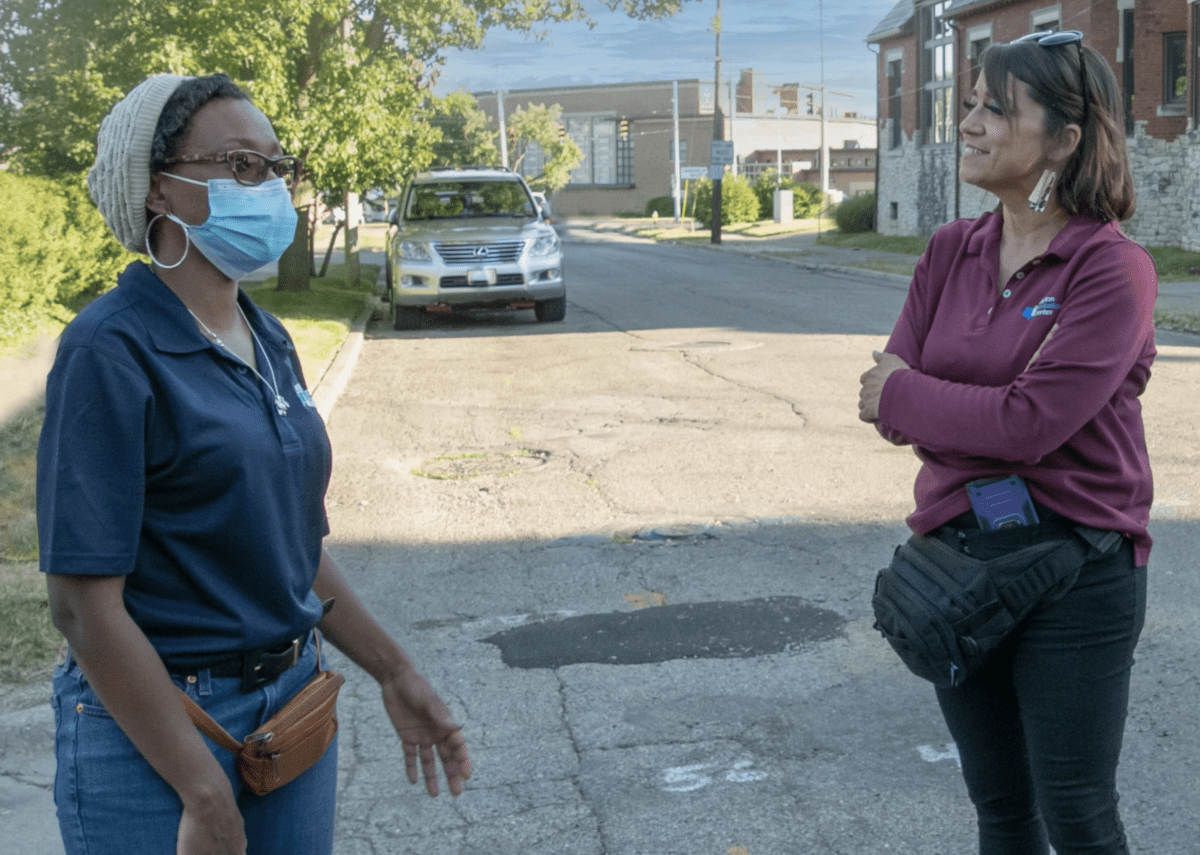Albuquerque created its Community Safety department in 2020. Community Safety is its own city department, like the fire department or the police department, and is considered the city’s third branch of public safety, Ruiz-Angel said. It is one of the largest crisis response programs in the country, with 130 employees. When a call comes into 911 that the Community Safety department is eligible to respond to, dispatchers will send one of three types of Community Safety teams.
In Dayton, Ohio, the city established a Mediation Response Unit (MRU) in 2022 to respond to low emergency 911 calls, such as calls involving disputes between neighbors, child custody exchanges, or barking dogs, Raven Cruz Loaiza, a coordinator for the program, said in an interview. The MRU is small—just seven members—and is a program under the umbrella of the Dayton Mediation Center, a city agency. MRU members are unarmed and wear black pants and maroon polos with “Mediator” written on the back. The goal is to resolve conflicts between community members without police involvement.
While many crisis response programs are new, they’re already delivering results. Since it began operating two years ago, the Albuquerque Community Safety (ACS) department has diverted more than 33,000 calls from the city’s police department, according to data shared with The Appeal. In a significant portion of ACS calls, the department connected the person in crisis to service providers—such as shelters or substance use programs—instead of jail cells. A 2022 Stanford University study of Denver’s crisis response program found that reports of low-level crimes fell by 34 percent in neighborhoods where the city’s Support Team Assistance Response (STAR) program operated. The study also suggested that the crisis-response team saves taxpayers money, as incarceration is more expensive than treatment and support services.
Yay! Finally some unignorable proof that non police conflict resolution works, we couldn’t be more pleased!
…that the Republicans will continue to ignore.
Doesn’t matter if it’s built anyway. They can ignore it all they want whilst we dismantle the shitty systems in place.
Albuquerque created its Community Safety department in 2020.
with 130 employees.
the Albuquerque Community Safety (ACS) department has diverted more than 33,000 calls
So 33,000(cases)/130(workers)/4 (year)/260(~ work days a year)… each worker handles 0.24 cases a day… And that’s “unignorable proof” that it’s working? No offense, but this screams TSA levels of incompetence to me if we’re talking about results.
But the article confuses me. It says that ACS was created in 2020, then referenced “since it started 2 years ago” (2022, article was written 2024)… the number could be 0.48 cases a day/employee… which is still very very little. By that metric half the days people are at work, they’re not active on any case… at best.
I’m wholly on-board for a non-police response to some calls, or I guess in a more perfect world a social worker embedded police presence (since you just never know… a social worker on every call a police officer goes on could be interesting overall. Most cops are solo these days anyway). But this article is easily ignore-able if you’re just looking at the numbers of what’s being discussed.
Edit: Formatting.
You’ve taken their current employee count, as the biggest department of its kind, and assumed they started with that on day 1, which is an unrealistic assumption to make without evidence.
Cool. Then you can give me a better figure or statistic? I mean even if we make the 33000 representative of 1 year (giving them either 1 or 3 years of ramp up time) it’s still not even close to good. .24 cases A DAY is so bad that even if you 8x it it’s not good.
I’ve replied to another one of your comments.
There are many reasons why I think you’re analysis is misleading.
Individual Productivity is the wrong metric here. If you want to see the impact, I would say percentage of police calls diverted would be better. I will also say, these are still early days (whether it is 2 or 4 years), and this kind of thing takes time to establish. Cops and community members have to know it is an option and utilize it.
Cops and community members have to know it is an option and utilize it.
Read the article. They divert calls to 911. This has nothing to do with cops/people knowing it’s an option but the department diverting calls to themselves rather than taking up 911/police/other first responder duties. I would not suspect that it takes 2-4 years for a team that is directly tied into the system, monitoring and diverting 911 calls to establish themselves… and if they do. Then they are VERY ineffective.
I would say percentage of police calls diverted would be better.
I would agree to some extent… So how come they didn’t provide those metrics? I’m left to only evaluate based on the ones they decided to provide. But a reason %diverted is bad, if 10 calls come in and they diverted 8 of them, 80% is great! except… that 130 person team only doing 10 calls per day seems quite underwhelming. So I would actually much rather the raw number of how many calls occurred during the same 2 or 4 year period overall to compare diverted/overall and make an actual fair assessment there.
Edit: I decided to do their job for them a little bit. Pesky Journalists…
A study found between 2019 and 2021, New Mexico residents called 911 the most out of all 50 states with 1,169 calls per 1,000 residents, according to a news release.
So Albuquerque has a population of 558,736 currently according to some random site. I’ll just assume that number for 2020-2024 statically.
so 558736*1.1693 (annual), 653330 calls / year. over 4 years… 2613320
So they took 33000/2613320= 1.26% of calls over the 4 year period… double that if it’s really 2 years.
This infographic has more relevant info from 2023.
Also note that taking calls isn’t the only thing the group is responsible for. They do things like needle pickups, homeless outreach, etc additionally, acs doesn’t only respond to 911 calls:
While responding to 911 calls is our primary focus, ACS responders will be dispatched through additional methods, including referrals, self- dispatch, and 311 tickets. ACS will also respond to calls from 988, the national behavioral health crisis hotline, when it launches in 2022.
Taking some good news and immediately trying to portray it in a bad light is not exactly the way to push society forward. Actively looking to portray the start of such programs as “inefficient” and being a waste of taxpayer dollars can discourage other such programs from starting, which is a shame especially if the analysis wasn’t fully informed.
Taking some good news and immediately trying to portray it in a bad light is not exactly the way to push society forward.
Taking “good” news and assuming that it’s always good even ignoring obvious problems is also a bad thing.
Actively looking to portray the start of such program
So how long then until it’s allowed to be evaluated? It’s already been 4, 3, or 2 years. Does it need 100 years before it can be analyzed? The fact that you think we can’t look at something because it’s “new” is stupid. And I didn’t start my day thinking “I’m going to dunk on this program!”. Instead I ran into the story saw the pure blinded “positivity” with NO evaluation of any possible negativity. I’m only offering a more realistic view of what this actually is. I never once said it’s a bad program in of itself. It’s clearly a beta of sorts and there’s shit to work out. Claiming that it’s all roses is bullshit.
which is a shame especially if the analysis wasn’t fully informed.
Until you can provide something more substantive… the “analysis” which wasn’t much of one seems to have been dead on with everything I’ve seen thus-far, including your new document which I find dubious anyway… since it claims yet a DIFFERENT starting date than ANY other source I’ve seen.
Here’s the thing. You’re the one asserting that it’s inefficient, so it’s really up to you to make sure your evidence and reasoning is right.
You keep asking for analysis from me, but I don’t need to provide my own analysis to point out the false assumptions you’ve made in yours, resulting in potentially misleading analysis. The correct action to take is to either correct the assumptions, or state that those are assumptions you are making in your analysis.
The fundamental thread behind your analysis is that 130 employees don’t divert enough calls to justify their existence, when in reality you didn’t realize that those calls aren’t the sole responsibility the group has. So how much water does the analysis even hold?
I’m not saying you’re a bad person. I’m saying you’re looking to “offer a more realistic view of what this actually is” before having a full understanding of what it actually is. The acs page linked to the article has a transparency page with regular reports like the one I shared. I’d consider those to be good primary resources. Go ham!
but I don’t need to provide my own analysis to point out the false assumptions you’ve made in yours
I’ve made NO false assumptions, there’s nothing FALSE about me taking the numbers that the article gives and doing basic math with it to try and find what the real value of the service is. The numbers given show results so woefully weak that it doesn’t matter if you 8x the results I got, which I’ve already outlined. I am not showing something in any light other than how it was presented to me, if you don’t want it in that light then you need to yell at the article writer for doing a piss poor job.
when in reality you didn’t realize that those calls aren’t the sole responsibility the group has.
So when I said “even if you 8x”… I didn’t account that there could be additional workload? Not at all! Oh boy I must be fucking retarded then cause I swear that’s what I read in my post. I guess words just don’t have meaning.
Taking even your infographic where they claim that they’ve done 3296 calls (both diverted calls and other sources) in Sep 2023. That’s still REALLY bad. 30 day month where you’d expect workers to work about 20 of those days. 3296/130/20… a mere 1.27/working day/worker AT BEST. Or an average case load of 6 hours and 18 minutes per case. Do you think that it takes 6 hours to drive out to a house/apartment and conduct a welfare check (keep in mind that a good amount of these calls will be non-issues where they walk up to the door, knock, talk to the person for 10 minutes and leave)? Adding more information narrows down your argument that I don’t have sufficient information, therefore it must be good! Yet we still come up with REALLY BAD numbers as it gets adjusted with your moving goalposts.
You seem to be completely misunderstanding my point. That’s on you.
As I said. I’m all for it. But it needs to do better if it’s going to stick around.
I’m really glad to see peograms like this, I didn’t even know that was a thing. Is there an umbrella organization that is organizing awareness for these crisis responders?






